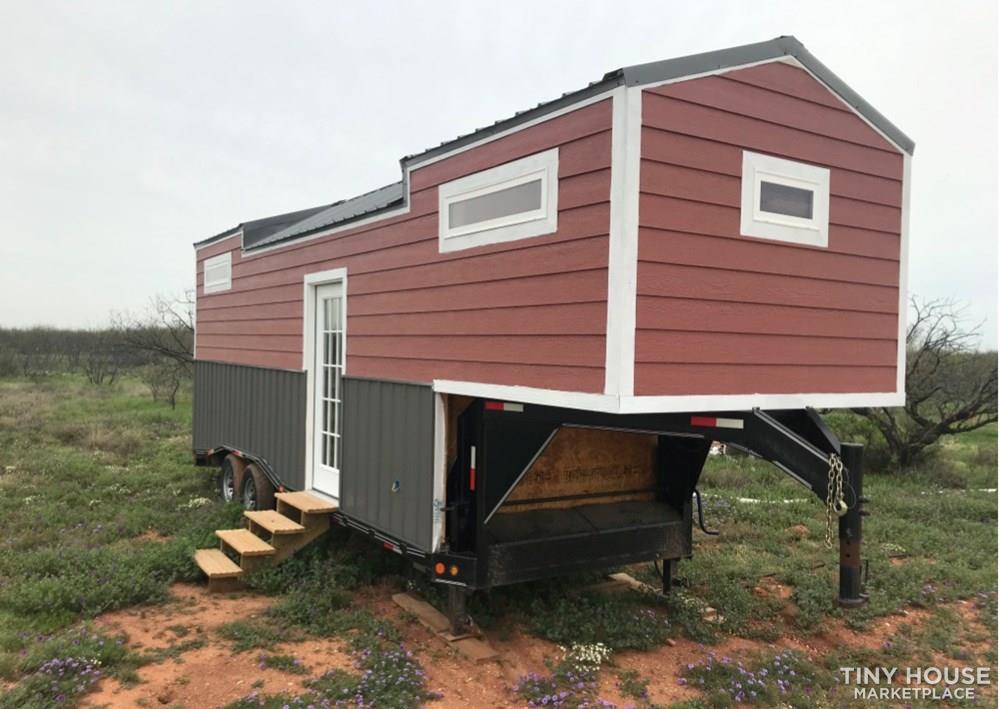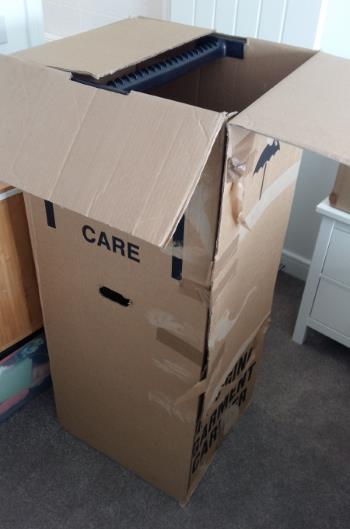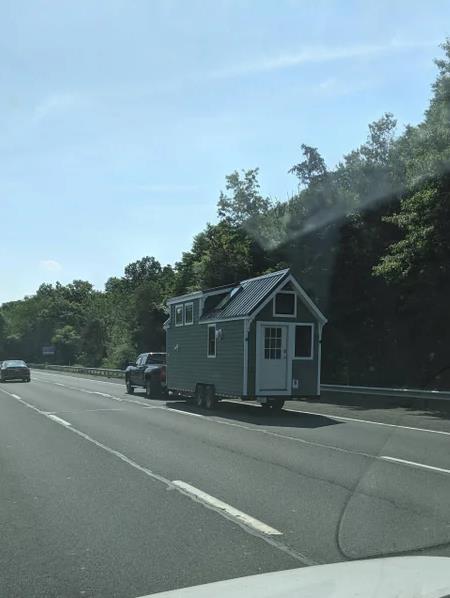Blog

How Often Can You Move A Tiny House?
How Often Can You Move A Tiny House?
Being able to pack up and move anywhere else in the country is part of the ‘tiny house dream’. After all, your tiny house is on wheels so if you fancy exploring Yosemite National Park you can just tow your tiny home to California, right?
A tiny house can potentially be moved every 3-6 months. However in addition to all the hassle of packing up and towing your tiny house somewhere else (and finding tiny house friendly land to park in), you will need to think carefully about wear and tear.
What exactly do we mean by this? This article explores these points (and more) below.
When you buy through links on our site, we may earn an affiliate commission. As an Amazon Associate I earn from qualifying purchases.
Wear and Tear
You have moved home before, right? It invariably involves a week (or more) of painstakingly wrapping your items in bubble wrap, packing it in boxes and repetitively sealing up each full box before getting a new box ready for packing. Days later, it is moving day: which involves painstakingly loading up a truck and moving to your new place… before unloading and unpacking each box, repetitively removing all the bubble wrap and finding the right place for each of your items. Ugh!

And even though you (or your packing company) will have diligently packed everything, something will break or go missing. It is part of the ‘fun’ of moving (not!). This is partly what we mean by wear and tear when moving your THOW: some of your prized possessions will unfortunately break in the (time consuming) moving process. Plus cupboard and kitchen cabinets drawers can swing open, causing the items inside to spill out.
In addition, the building itself will be subject to wear and tear. After all, just because a tiny house is on wheels does not mean that it can be easily and safely moved. The pipework and water tank could pick up some damage along the way, whilst batts insulation has been known to slide down the walls due to all the vibrations when moving.
Moving a tiny house is not easy, and it will have an effect on your possessions and house – which is why we recommend moving no more than every 3-6 months if possible. Even if you infrequently move, though, read on to get some tips on how to protect your items.
Protecting Your Possessions
You will know the obvious things to do to protect your items: wrap anything fragile (or breakable) in bubble wrap, and make sure it is packed securely so that it (or its storage container) cannot move around. Moving boxes are affordable and ideal for this, however they take up a lot of space (even when collapsed) so you will either need adequate space in your loft for these, or buy them each time (and recycle them after your move). If you want to buy them each time, you might be able to fit all your tiny house possessions into 10 moving boxes which can ‘just’ be under $30 each time.
- 10-Pack of medium (19x15.5x14.5) moving, banker, or storage boxes with open-side handles
- Made of strong corrugated kraft cardboard with a reinforced double bottom
- Great for moving, storing personal or business items, documents, decorations, and more
- Can be collapsed for storage and reused multiple times
- Transport and stack easily with side handles and flat lift-off lids
- Easy assembly by hand; no tape required
Next up, be sure to strap any large movable items like fridges and storage cabinets to a fixed point. This might mean laying your tall cabinets down on the floor and securing them in place with rope, and using moving straps to secure your fridge. Trust us, you do not want a heavy fridge or cabinet moving around during your hundred mile THOW removal!
As we mentioned earlier, the doors of cabinets can swing open so use tape or rubber bands to ensure that cabinets doors cannot open. This is worth doing even if you have removed all the items from the cabinet, because a door that is swinging around loads can either bang into things (damaging them) or the door hinges might wear down and break.
Finally, items in your loft will move around a lot so bring everything down from your loft apart from soft items like mattresses. It is much better to have your random loft-stored items packed in (with your other items) on your ground floor.
Protecting the Actual Building

Moving a tiny house is not always easy. You might picture a simple ride along the highway, however the main risk comes from the start and end of the journey. This will involve tight bends, high winds, going down small access roads and lots of abrupt movements when trying to park.
These can all lead to damage to your building, especially because timber framed buildings can be a little more brittle than earthen/masonry construction methods and your water system and pipework may not hold up too well to the constant movement and vibrations. Of course, you will want to move your tiny house from time to time, and a timber frame is the only viable option (there is no practical way that a very heavy masonry house can be towed along the highway!).
With all that said, we would recommend the following tips to protect your building when frequently moving your tiny house:
- Do not use standard batts insulation, which can collapse and compact down the wall leaving inconsistent insulation. Either use paper-backed batts insulation and staple this down, or use an alternative insulation such as spray foam.
- Check any easily accessible bolts and screws regularly. Make sure that the building and any fixtures/fittings are as secure and rigid as possible.
- When the ground is not too wet, try and get under your trailer with a torch and check that the trailer is in a good state of repair. A poor weld or failing joint will be a big cause for concern.
- Installing window shutters is key, as this will protect against small objects and high winds during transit. Boarding them out with plywood/OSB will work just as well.
- Drain down any water tanks and all pipework so that there is as little water in your system as possible. Water can be quite heavy, and it can move with a large force when your tiny house is being towed, so protect your water system by draining it down.
- You can consider using a service like a1autotransport.com who specialize in moving heavy equipment and large vehicles. They may be able to accommodate your needs!
Finding Tiny House Friendly Land
One of the general issues with tiny houses is the lack of public zoning laws for them. If you do not have a friend or family’s private land to park on, you will have to carefully plan out where you will park your tiny house up-front. Some RV camps will allow tiny houses, but some will not.
In addition to finding an actual parking spot, you will also need to consider:
- What the ground rent will be. A spontaneous ‘YOLO’ move is a great idea, but do not assume that ground rent will be cheap – especially in a state whose zoning rules are unfriendly towards tiny houses.
- What utilities will be available. Can you easily hook up to electric, water and drainage? Do you have a backup plan (propane fuel, composting toilets and bought-in water?) if your new location is fairly off-grid?
- The actual ground level. Is your planned parking spot ‘tiny house ready’ or will you need to level things before you settle in for the night?
- Is the ground swampy? There is nothing worse than almost getting to your destination, only to hear the awful sounds of wheels spinning. A tiny house whose wheels are stuck in swampy ground is next to useless, and it can require some serious skill to get out of the position.
- Is access to the site good? Will you have to tow your tiny house down very thin access roads, or take a hard left turn in busy traffic? Are there any trees and bushes overhead (anywhere along the driveway or access lane) which will block tall vehicles like – you know – a massive tiny house being towed! The worst case, of course, is that you will have to spend a few hours trimming trees (so be prepared for this possibility!).
We are not trying to put you off moving your tiny house: we would just advise you to be prepared and do your homework before you set out on your new adventure!
Additional Questions
What are the typical costs when moving your tiny house? The price of moving a tiny house can vary massively, as the UShip ‘trailer homes’ page shows. However a shorter intrastate journey might only be a couple of hundred bucks, whilst a multi-state journey will probably run to over $700 (in which case, get a W-9 which any reputable tiny house mover would be happy with).
What are the alternatives (to a tiny home) if you will be moving frequently? An RV is practically designed from the ground up for frequent moving, meaning that the only real risk would be to your possessions. Airstream trailers/campers are also commonly used for frequent moves.
Why are tiny houses put on wheels if they are hard to move? Many states and cities are not too friendly to tiny houses unfortunately, especially ones on a foundation which some areas then instantly consider ‘too small’ to live in as a permanent home. So tiny houses are put on wheels (THOWs) to often skirt some of the silly zoning rules which prevent tiny houses from being enjoyed in a similar fashion to RVs and campers.
